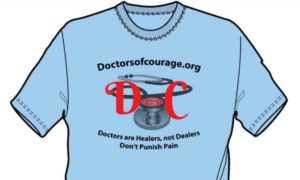David E. Smith has emerged as a true hero in the ongoing battle for justice, particularly for chronic pain patients, as he stands up to the might of U.S. government agencies. Following in the footsteps of human rights champions like Zena D. Crenshaw-Logal Esq., Smith has taken the courageous step of suing federal entities that have inflicted injustice upon vulnerable patient populations. His fight, much like Logal’s, centers around the misuse of power in healthcare systems, where U.S. government agencies often prioritize bureaucratic control over the well-being of patients. Through his lawsuit, Smith demands accountability for flawed prescription monitoring programs like Narxcare and PDMP, which have dehumanized countless patients by reducing their care to mere algorithmic scores. His actions serve not only as a personal quest for justice but also as an inspiration to other pain warriors, pushing back against oppressive government policies and advocating for the dignity and humanity of patients.
Smith’s efforts echo the bravery and resilience of activists like Crenshaw-Logal, making him a symbol of hope for those battling medical injustice writing to Doctors of Courage, “ Dr. Norman Clement’s blog today is about the Bamboo software, the Narxcare scores, and the PDMP. https://youarewithinthenorms.com/2024/05/10/study-shows-narxcheck-systems-used-by-nearly-all-hospital-and-pharmacies-to-be-misbranded-danger-to-healthcare-and-use-must-be-suspended-immediately-by-fda-repost-update-draft/
I have now recognized that the use of these software programs and the design of their use by “health care providers,” (doctors and pharmacists), is yet another EXPERIMENT designed and implemented EXACTLY as the famous Milgram Experiment, where subjects were told to administer electric shocks to a person behind a partition who screamed with pain after each shock and then eventually went silent. This was designed to measure the willingness of the subject to follow the directions/orders of an “authority figure,” even when those directions conflicted with the subjects own conscience. So, I wrote to Dr. Norman Clement: “This Narxcare and PDMP software is EXACTLY like the famous Milgram Experiment. The doctors and pharmacists using the PDMP and Narxcare software, are allowing it to OVERRIDE THEIR JUDGMENT, causing them to continue to INFLICT TORTURE upon legitimate pain patients, no matter the outcome, all while ignoring their clinical judgment, following the directions that the “computer” gives them. In the Milgram Experiment, subjects believed that they were administering electric shocks to a person behind a partition, whom they could not see, and could only hear. The study was done to ascertain the willingness of the subjects to follow directions from an authority figure, who directed them to perform acts that conflicted with their personal conscience. These directives from the agencies and the use of these software programs are EXACTLY the same – I believe they are measuring the willingness of the “health care providers and pharmacists” to obey the “authority figures” (CDC, FDA, DEA) to INFLICT TORTURE upon pain patients, even when their own judgment should tell them that this is harmful. This process has been further complicated by the fact that our society has now been propagandized to believe that all opioids are “bad,” even for use in legitimate medical settings. THE TIME TO RISE UP IS NOW”—David Smith
David E. Smith’s analogy comparing the Narxcare and PDMP systems to the Milgram Experiment opens a powerful dialogue about the dehumanization of patients in healthcare. These U.S. Government automated software systems, designed to control and monitor opioid prescriptions, reduce human lives to mere data points. Healthcare providers, in turn, are often forced to abandon their clinical judgment, becoming agents of harm rather than healers, as they follow the dictates of a computer algorithm.
David’s observation raises the crucial question: What is a human life worth? This resonates deeply with the story portrayed in Schindler’s List, where individuals’ lives are similarly reduced to numbers by those in power. The film illustrates how Amon Göth, the Nazi officer overseeing the Płaszów concentration camp, viewed Jews as expendable, killing thousands with bureaucratic precision, while Oskar Schindler gradually recognizes the value of each human life, risking everything to save over a thousand Jews from certain death.
In both narratives—Smith’s commentary on the PDMP system and Schindler’s shift in perspective—we witness the devastating impact of mechanized cruelty, whether through a heartless algorithm or the atrocities of the Holocaust. Schindler’s moral awakening serves as a metaphor for the urgent need for healthcare providers to challenge systems like Narxcare that push them to commit ethical violations. Just as Schindler took bold actions to protect his workers from the brutality of the Nazi regime, today’s doctors and pharmacists must reclaim their moral responsibility and protect their patients from the dehumanizing forces of these technologies.
Smith’s comparison between Narxcare and the Milgram Experiment highlights this ethical dilemma. In the Milgram study, participants were instructed by an authority figure to administer what they believed were electric shocks to another person, despite hearing their screams of pain. The experiment sought to understand how far people would go in following orders, even when it conflicted with their moral conscience. Similarly, Narxcare’s use in healthcare systems places doctors in the same ethical quandary, asking them to rely on faulty data that punishes legitimate pain patients and overrides their judgment, much like the participants in Milgram’s experiment continued administering shocks under orders.
In Schindler’s List, a turning point occurs when Schindler sees the girl in the red coat during the liquidation of the Kraków Ghetto, realizing for the first time the stark, individual human cost of the Holocaust. Similarly, Smith’s reflection on PDMP software underscores the urgent need for healthcare providers to look beyond algorithms and rediscover the human lives at stake in their decisions. Both narratives compel us to reflect on the question: What is the value of one human life?
In Schindler’s case, as he transforms from war profiteer to humanitarian, he spends his entire fortune bribing officials and manipulating systems to save lives. His effort culminates in the creation of Schindler’s list—a roster of 1,100 Jews who would avoid Auschwitz and be sheltered in his factory, an act that profoundly demonstrates that “whoever saves one life saves the world entire.” In healthcare today, providers face a similar moral reckoning, one that challenges them to fight back against flawed systems like Narxcare and PDMP that reduce human beings to scores and data points.
Through Smith’s analogy, the human cost of these software systems becomes clear. Just as Schindler recognized the intrinsic value of each life, healthcare providers must challenge the dehumanization inherent in these systems. By doing so, they can honor their commitment to healing rather than harming, making decisions that prioritize human dignity over bureaucratic control.
David Smith’s reflection on the legacy of Zena D. Crenshaw-Logal, Esq., a tireless advocate for human rights and a voice against medical injustice, honors the profound impact she made on both the legal and medical advocacy fields. As a fellow pain warrior, Smith deeply connects with Crenshaw-Logal’s fight for transparency and justice in the medical system, particularly concerning the treatment of chronic pain patients.
Zena Crenshaw-Logal’s Esq. work, particularly through organizations like the National Judicial Conduct and Disability Law Project (NJCDLP), emphasized the importance of judicial accountability and ethical oversight in healthcare and legal systems. Her dedication to challenging corruption and systemic abuse within the judicial process resonates with the ongoing struggles faced by chronic pain patients, especially those targeted by flawed prescription monitoring systems like PDMP and Narxcare. Smith sees her as a beacon of hope in a world where bureaucracy often dehumanizes and harms the most vulnerable.
Crenshaw-Logal was also a staunch advocate against the militarization of medicine, where patients are treated as potential criminals rather than individuals deserving compassionate care. Smith’s comparison of Narxcare and PDMP to the Milgram Experiment highlights the same issue that Crenshaw-Logal fought against: the blind obedience to authority at the expense of human dignity and patient rights. In her work, she called attention to the injustices faced by marginalized communities and pain patients, many of whom have suffered due to the rigid, often punitive frameworks imposed by healthcare institutions and government bodies.
Smith’s tribute to Crenshaw-Logal acknowledges that she laid the groundwork for continuing the fight against these injustices. Her legacy inspires activists to keep challenging harmful policies that disregard patients’ well-being. In this sense, Smith’s own advocacy becomes a continuation of her mission to fight for dignity, rights, and humanity in healthcare. By honoring Zena D. Crenshaw-Logal’s legacy, Smith emphasizes that her work has paved the way for others to challenge the systems that perpetuate medical injustice, a cause that remains vital to the chronic pain community and beyond.
The Author received an honorable discharge from the U.S. Navy where he utilized regional anesthesia and pain management to treat soldiers injured in combat at Walter Reed Hospital. The Author is passionate about medical research and biotechnological innovation in the fields of 3D printing, tissue engineering and regenerative medicine.


Evinced by design, to reduce us all to absolute despotism,
The tortures are the hero’s, whilst the humane doctors are arrested and jailed.
Torture is their new commodity, thus they dance on all our graves, Giving us laws on how we are to die in forced Agony. Proving Evil truly is sufferable, For no-where on Gods earth,would torture upon our sick,our dieing,our children, ever be the right thing to do,not even under the ,”color of law,” or kolodny guidelines,,,,,,,
jmo,,maryw
Sorry Doc.Cheek,,,didn’t have my coffee yet w./ the last 1,,,,,Im Glad we have a fellow human right warroir,,,,For it will take allll of us,,,to fix this torturous mess onto humanity,,,so it never happens again to another generation of doctors ,and the sick they treat,,,jmo,,,maryw
That’s beautiful maryw, and is the absolute truth.